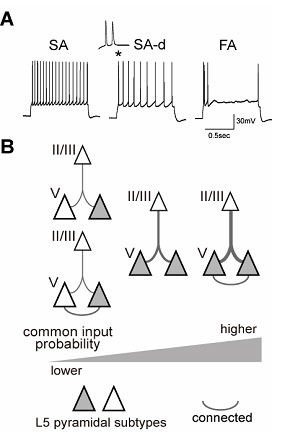The cortical circuit includes networks of highly interconnected pyramidal neurons. Here, we investigated whether pyramidal cells form subnetworks depending on pyramidal subtypes. We classified layer 5 pyramidal cells in rat frontal cortex into three physiological subtypes based on the presence (SA-d type) or absence (SA type) of an initial burst in neurons displaying slowly adapting spike trains, or fast spike frequency adaptation (FA type) against current pulse injections. Pyramidal cells projecting to the particular subcortical areas were correlated with the physiological subtypes. Focal glutamate stimulation of a L2⁄3 pyramidal cell induced EPSCs in SA and SA-d cells more frequently than in FA cells. FA cells in upper L5 received more inputs from the upper L2⁄3, and those in lower L5 received inputs from cells in lower L2⁄3, suggesting topographic interlaminar projections to FA cells. Dual recordings from L5 pyramidal cells revealed that common input probability that two L5 cells share inputs from a L2⁄3 cell was high in cell pairs of the same subtypes, compared with those in different subtype pairs. Furthermore, the common input probability was highly selective when cell pairs of the same subtypes, but not different subtypes, had connections between them. Our results suggest that L2⁄3 pyramidal cells selectively innervate L5 cells, depending on their firing subtypes.

A, Voltage responses to current injections in SA, SA-d, and FA type L5 pyramidal cells. Asterisk indicates initial doublet spikes. Inset in SA-d, initial doublet (*) at an expanded time scale and reduced voltage scale. B, Schematic diagram of interlaminar divergence selectivity from L2⁄3 to L5 pyramidal cells. Line thickness represents connection probabilities. Open and dark triangles indicate different pyramidal subtypes.